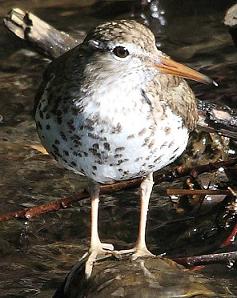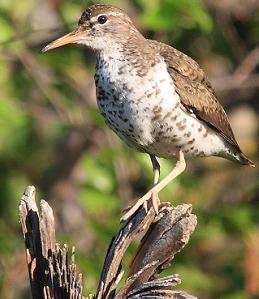Spotted Sandpiper 
Identification and Pictures
(Actitis macularius)
Spotted sandpipers are a small shorebird about
7 to 8 inches. The birds are constantly bobbing the tail,
with their bodies leaning forward. They are olive brown
above and white with round black spots below. They have
a straight
beak which is yellow or orange with a black tip in breeding
plumage. There is a dusky patch on the breast near the
shoulders, enclosing a white wedge between it, and the
wing. There is a white line over the eye. In the
fall, and winter they lose most of the spotting. They fly with
the wings held stiffly downward using shallow wing
strokes. These are solitary birds not often seen in
flocks.
Photos by Keith
Lee. The camera I use is the Canon
EOS 40D. Visit All-birds store


Young birds resemble the adults but have dark
edges on the back feathers.
Spotted Sandpiper Sound
They call out a clear peet or pee-weet-weet.
Sound
Preferred Habitat
This is the most widespread of all the
sandpipers. The summer range is from Alaska through
Canada, and most of the U.S. In winter they migrate to
far south U.S., and into South America. They may be
found along
stream sides, ponds, and lake shores. During migration,
and in winter they can be seen anywhere there is water from
streambeds to seashores.
Breeding and Nesting
Unlike most birds the female arrives in the
breeding grounds before the male. She establishes, and
defends the territory while trying to attract a mate. The nest is made of stems, and
grass concealed under vegetation near rivers, streams, or
lakes. The female lays 3 to 5 buff spotted eggs with blotches. When she lays eggs they may be from several different males. After laying the eggs she
will leave them for the male to incubate while she searches
for another mate. The eggs will hatch in around 20 days
and the male will take
care of young birds for about 4 weeks. The female may
breed with up to 4 males, each raising a clutch of eggs.
She may raise the last one herself.
blotches. When she lays eggs they may be from several different males. After laying the eggs she
will leave them for the male to incubate while she searches
for another mate. The eggs will hatch in around 20 days
and the male will take
care of young birds for about 4 weeks. The female may
breed with up to 4 males, each raising a clutch of eggs.
She may raise the last one herself.
Food
Sandpipers feed on a variety of insects, and invertebrates
normally feeding along the shoreline, but may also grab
insects from the air.
To learn about other favorite
birds click here

|
